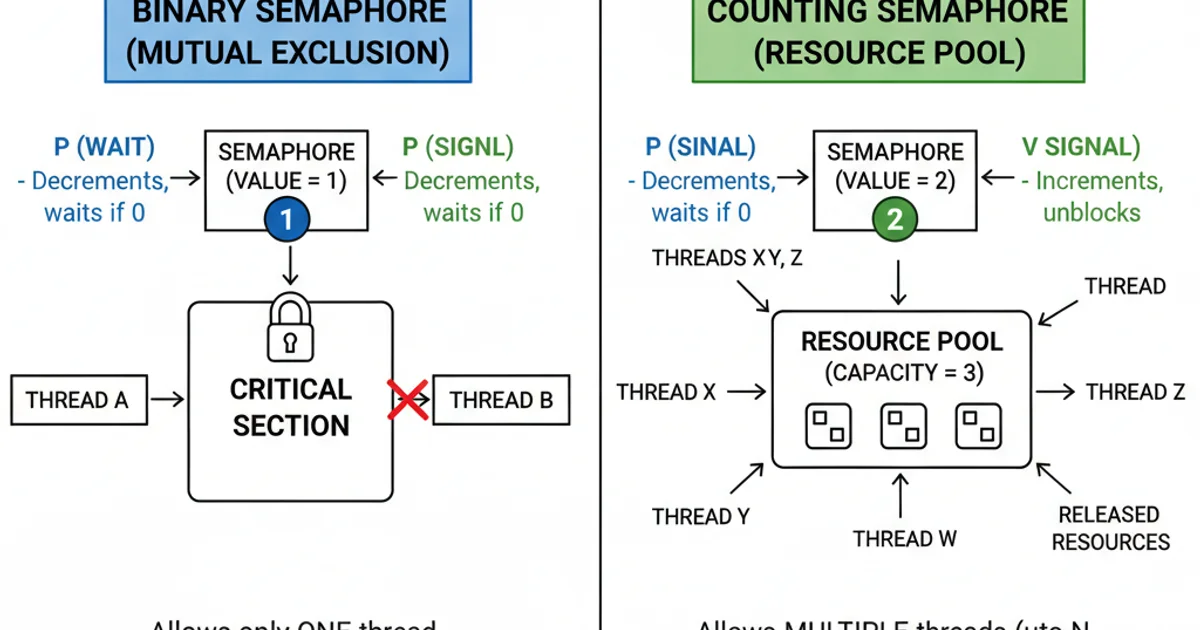What is the original meaning of P and V operations in a context of a semaphore?
Categories:
Understanding P and V Operations: The Core of Semaphore Synchronization

Explore the original meaning and fundamental role of P and V operations in semaphore-based synchronization, crucial for managing shared resources in multithreaded environments.
In the realm of concurrent programming, ensuring that multiple threads or processes can safely access shared resources without causing data corruption or race conditions is paramount. Semaphores, introduced by Edsger W. Dijkstra in 1965, are a fundamental synchronization primitive designed to address this challenge. At the heart of semaphore operation lie two atomic operations, historically known as P and V. Understanding their original meaning and how they interact is key to grasping the essence of thread synchronization.
The Origins: P and V Operations
Dijkstra, a pioneer in computer science, named these operations using Dutch mnemonics. The 'P' operation stands for proberen (to test) or passeren (to pass), while the 'V' operation stands for verhogen (to increment) or vrijgeven (to release). These names reflect their core functions: P attempts to acquire a resource, and V releases it. They are often referred to as wait() and signal() (or post()) in modern programming contexts, but their underlying logic remains the same.
flowchart TD
A[Start Thread/Process] --> B{Execute P Operation (Wait)};
B -- Semaphore Value > 0 --> C[Decrement Semaphore Value];
C --> D[Access Shared Resource];
D --> E{Execute V Operation (Signal)};
E --> F[Increment Semaphore Value];
F --> G[Continue Execution];
B -- Semaphore Value <= 0 --> B;
style B fill:#f9f,stroke:#333,stroke-width:2px;
style E fill:#ccf,stroke:#333,stroke-width:2px;Flowchart illustrating the P and V operations in a semaphore's lifecycle.
The P Operation (Wait/Decrement)
The P operation is used to acquire a resource. When a thread or process executes a P operation on a semaphore, it performs two actions atomically:
- Decrement the semaphore's value: The semaphore's internal counter is reduced by one.
- Check the value: If the resulting value is negative, the thread is blocked (put to sleep) and added to a queue associated with the semaphore. It will remain blocked until another thread performs a V operation, making a resource available. If the value is zero or positive, the thread continues execution, having successfully acquired a resource.
void P(semaphore *s) {
s->value--;
if (s->value < 0) {
// Add this process to s->queue
// Block this process
}
}
Conceptual C-like pseudocode for the P operation.
The V Operation (Signal/Increment)
The V operation is used to release a resource. When a thread or process executes a V operation on a semaphore, it also performs two actions atomically:
- Increment the semaphore's value: The semaphore's internal counter is increased by one.
- Check the value: If the resulting value is less than or equal to zero, it means there are threads waiting on the semaphore. One of the waiting threads is then unblocked (woken up) and moved from the semaphore's queue to the ready queue, allowing it to contend for CPU time. If the value is positive, it simply means a resource has been made available, and no threads were waiting.
void V(semaphore *s) {
s->value++;
if (s->value <= 0) {
// Remove a process from s->queue
// Unblock that process
}
}
Conceptual C-like pseudocode for the V operation.
Semaphore Types: Binary vs. Counting
Semaphores come in two primary forms, both utilizing P and V operations:
- Binary Semaphores (Mutexes): These semaphores have a value of either 0 or 1. They are primarily used for mutual exclusion, ensuring that only one thread can access a critical section at a time. A binary semaphore initialized to 1 acts like a lock: P acquires the lock, V releases it.
- Counting Semaphores: These semaphores can have any non-negative integer value. They are used to control access to a resource that has multiple identical instances. For example, a semaphore initialized to 5 could represent 5 available printer slots. Each P operation consumes a slot, and each V operation releases one.

Binary semaphores for mutual exclusion vs. counting semaphores for resource counting.
Practical Implications and Modern Usage
While the terms P and V might seem historical, their underlying principles are fundamental to modern concurrency constructs. Operating systems and programming languages provide abstractions like mutexes, condition variables, and semaphores (often with wait() and signal() or acquire() and release() methods) that implement the P and V logic. Understanding these original operations provides a deeper insight into how these higher-level synchronization primitives work to maintain data integrity and prevent deadlocks in complex multithreaded applications.